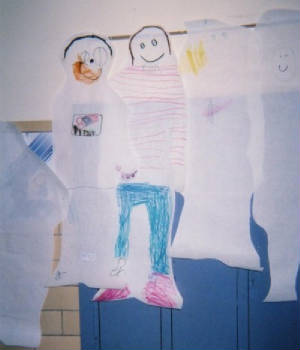|
During this week-long unit, kindergarten
students learned all about themselves. The lesson plans for this unit were developed
to help students become more aware of their bodies, their feelings, their likes and dislikes, etc. Throughout the week, students participated in a variety of activities including journal entries, creating
an “All About Me” book, and group discussion in order to learn and share about themselves.
The following lesson, Body Outlines, was created for students to become more aware of their bodies including what they look like, their
clothing, and their size (both independently and in comparison to their classmates).
This particular lesson included portions to appeal to different learning modalities such as:
Ÿ
kinesthetic learners (laying on the paper to be outlined, drawing)
Ÿ
auditory learners (hearing directions, discussing features with teacher and classmates)
Ÿ
visual learners (seeing the outlines, drawing features to see)
Also included are pictures of student work
and an explanation of assessment methods.
~~~~~~~~~~~~~~~~~~~~~~~~~~~~~~~~~~
Title: Body Outlines
Grade Level: K
Subjects: Science, Social Studies
Time Needed: Several class periods
Overview: Students will make life-size body outlines to learn about the parts of the body.
Materials or Equipment:
Ÿ large sheets of butcher block paper
Ÿ crayons or markers
Ÿ black permanent marker or pencil
Ÿ other materials as needed for decorating
Illinois State Standards:
State Goal 4: Listen and speak
effectively in a variety of situations.
Ÿ Listen effectively
in formal and informal situations.
- 4.A.1c: Follow oral instructions accurately.
State Goal 12: Understand the
fundamental concepts, principles and interconnections of the life, physical and earth/space science.
Ÿ Know and apply
concepts that explain how living things function, adapt and change.
-
12.A.1a: Identify and describe the component parts of living things (e.g., bird have feathers; people have bones, blood, hair,
skin) and their major functions.
- 12.A.1b: Categorize living
organisms using a variety of observable features (e.g., size, color, shape, backbone, etc.)
State Goal 23: Understand human
body systems and factors that influence growth and development.
Ÿ Describe and
explain the structure and functions of the human body systems and how they interrelate.
-
23.A.1: Identify
basic parts of body systems and their functions (e.g., heart, lungs, eyes)
Ÿ Describe factors
that affect growth and development.
-
23.C.1: Identify
individual differences in growth and development among people.
Goals: Students will create a life-size body outline and fill it in with personal characteristics while learning about self
and others.
Behavioral Objectives:
Students will be able to:
Ÿ Identify various
parts of their own body and their locations on the outlines (eyes, nose, hair, ears, mouth, etc.)
Ÿ Draw different
body features on their outlines.
Ÿ Identify similarities
and differences among the completed body outlines of their classmates.
Instruction:
Ÿ Have each child lay down on a piece of butcher block paper.
Ÿ Tell the children that you are going to draw the outline of their bodies, using the permanent marker or pencil.
Ÿ After the outlines are drawn, have the children write their names on the back.
Ÿ Then have them use the crayons or markers to color on their clothing and the different parts of the body such as hair,
eyes, mouth, etc.
Ÿ When the bodies are done, display them around the room/in the hall.
Closure:
Ÿ Have the students
guess who is who.
Ÿ Discuss similarities
and differences between the students – i.e. hair color, eye color, height, etc.
Adaptations:
Ÿ Repeat directions
and provide students who need additional help with directions one step at a time.
Additional challenges:
Ÿ
If extra time, students can continue to add things to this – for example, the students
can dictate some things about them for me to write on their outlines such as their favorite food, color, etc.
Ÿ
Students can label different body parts (e.g., hair, eyes, etc.) with help of teacher and/or
word wall.
Ÿ
Students can develop a method of measurement to determine how tall they are (State Goal
7.A.1a).
Reminders:
Ÿ
This will be completed during center time. As
a result, take only 4-5 students at a time (in small groups). While these students
are working on their outlines, call other students over one at a time to get their outlines done. This way, as students finish up, others can easily start working on theirs since the outlines will already
be completed.
Evaluation or Assessment:
Ÿ Students follow
directions and draw defining characteristics about themselves on the paper.
| Completed outlines |

|
| Completed outlines |

|
|
